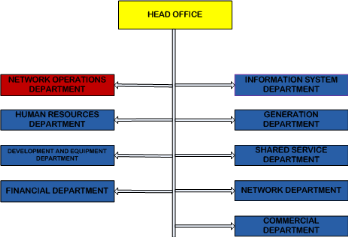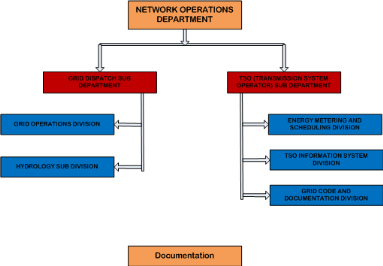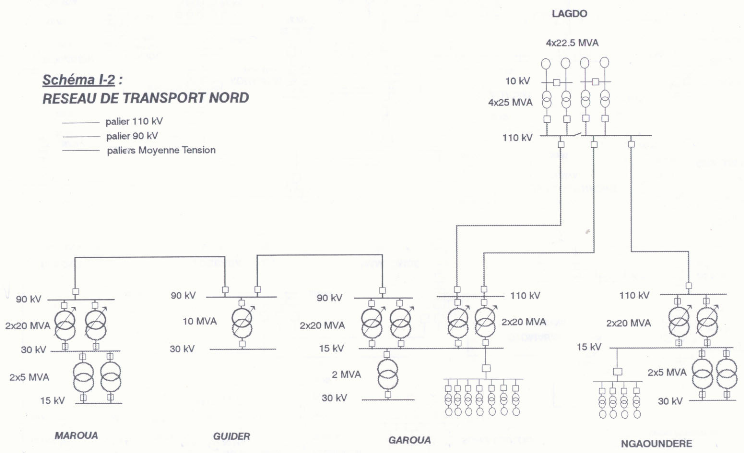1.2.2: Mission
The mission of AESS is to generate, transmit and distribute
reliable energy in compliance with safety standards as well as supply to
Cameroon industry reliable and clean energy with a high sense of social
responsibility. AESS caries out this mission within the framework of the
concession agreement and electricity sale license agreement that both determine
the perimeter, modalities and conditions.
1.2.3: Organization of AES
Sonel
1.2.3.1: Hierarchical
organization of AES Sonel
AESS is structured into departments, sub-departments,
divisions and services. It is organized into 9 departments and my internship
took place at the network operations department depicted in red in the figure
below which displays the organizational chart of AESS. Each of these
departments is subsequently organized into sub-departments made up of divisions
and services. The head office headed by the GM/CEO is organized into a
communications sub-department, a legal affairs sub-department, a compliance
sub-department, a safety and environment sub-department and a community
partnership section. Part of my internship also took place at the productions
department and the network departments.

Figure 1: Hierarchical
organizational chart of AESS
1.2.3.2: Organization of the
network operations department
The network operations department is organized into
sub-departments, sub-division and division as depicted in the figure below

Figure 2:
Organizational chart of the network operations department
The network operations department, future Independent System
Operator/Transmission network Operator (TSO), is presently responsible for
managing all the operations on the electricity transmission network. It carries
out this mission through the following divisions with their respective
functions
· Grid operations Divisions: Located at the Grid Dispatch
center in Magombe, Edea is responsible for supervision and control of the
electricity transmission network, data management, capacity planning and
operations planning.
· Hydrology Sub-division: Located at the Grid Dispatch
center, is responsible for managing and providing information concerning the
water levels and flow rates in the production dams, storage dams and on the
Sanaga and Benue river
· Metering and Scheduling division; responsible for
operations planning, metering, energy accounting and billing.
· Information system division: responsible for the
management (design, maintenance and support) of the information system used in
network operations management as well as the establishment of communication
procedures for the network operations department.
· Grid code and documentation division: establishment and
management of the grid code.
1.2.4: Description of the
AES Sonel network
AESS carries out its mission of generating, transmitting and
distributing reliable electrical energy of excellent quality in compliance with
safety standards through a generation network made up of both thermal and hydro
generating power stations, a transmission network made up of two isolated grids
(the northern grid and the southern grid) and a low voltage distribution
network.
AESS has an up-to-date an installed generation capacity of
about 900MW of which about 88% is hydro and 12% is thermal. Its two main hydro
power stations, Edea and Songloulou with installed generation capacities of
265MW and 384MW respectively are located on the Sanaga River. Another hydro
power station is located in Lagdo, on the Benue River, with an installed
generation capacity of approximately 72MW. These three hydro plants are
supplemented by thermal plants (HFOs and LFOs) located in Limbe, Douala,
Yaoundé and Bafoussam. About 30 aging diesel power stations that supply
isolated centers in the country.
Transmission through the SIG is done using MV (30/15KV) and HV
(225/90KV) power lines. The figure below depicts the whole SIG showing all its
substations and power stations.

Figure 3: The southern
grid [26]
As a summary and as can be seen from above, the SIG has
Ø 29 substations (both 225/90KV and 90/30/15KV)
Ø 2 hydro power stations
Ø 4 Heavy Fuel Oil (HFO) thermal power stations
Ø 5 light Fuel Oil (LFO, Diesel) thermal Power
stations
Transmission through the NIG is done using MV (30/15kV) and HV
(110/90kV) power lines respectively. The figure below depicts the NIG showing
all its power stations and substations

Figure 4: The northern
grid [26]
As a summary, the NIG is made up of
Ø 5 substations
Ø 1 hydro power station
Ø 1 thermal power station
Distribution is done through a highly radial LV (400/380V)
network using MV/LV transformers. AESS presently serves 528,000 customers,
which constitutes 60% of the urban population and 30% of the rural population.
Billing is done using 365 grid connected meters on the northern grid and 1300
grid connected meters MV points on the southern grid.
1.3: Problem location and
description
| 


